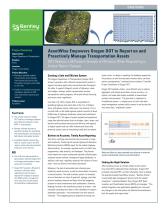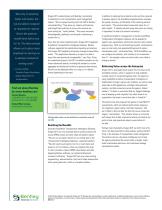 Website:
Bentley Systems Europe B.V.
Website:
Bentley Systems Europe B.V.
Catalog excerpts

CASE STUDY Project Summary Organization: Oregon Department of Transportation Solution: Roads Location: Oregon, United States Project Objective: • Develop a spatially enabled transportation asset management system that can be used throughout the agency and added to over time. • Establish a foundational business intelligence solution for DOT, state, and federal reporting and analytics. Products used: AssetWise AssetWise Empowers Oregon DOT to Report on and 'roactively Manage Transportation Assets DOT Realizes a 66 Percent Increase in Efficiency When Responding to Annual Report Changes Fast Facts • The solution improves Oregon DOT's ability to leverage corporate asset data and prepare to meet MAP-21 requirements. • Bentley software provided a powerful interface for assembling and analyzing data, and producing both tabular and spatial extracts. • AssetWise largely removed the need for custom code in the DOT reports, which reduced associated production costs and time. The shift from data assembly to data analysis allowed Oregon DOT to leverage existing data in ways previously not possible. Oregon DOT realized a 66 percent increase in efficiency when responding to annual report requirement changes to produce the HPMS extract, compared to more than three months before the AssetWise implementation. Creating a Safe and Efficient System The Oregon Department of Transportation (Oregon DOT) strives to provide a safe, efficient transportation system to support economic opportunity and communities throughout the state. It supports Oregon's system of highways, roads, and bridges; railways; public transportation services; transportation safety programs; driver and vehicle licensing; and motor carrier regulations. Like other U.S. DOTs, Oregon DOT is responsible for publishing highway and asset data in the form of federal, state, and agency reports, data layers, and extracts. This is no small task, as the state highway system consists of about 8,000 miles of highways (roadways owned and maintained by Oregon DOT). The types of assets tracked and reported on range from physical assets (such as bridges, signs, ramps, and barriers) and boundary assets (around districts and regions) to logical assets (such as traffic volumes and lanes) and proximity assets (such as intersecting roads and rest areas). Barriers to Accurate, Timely Asset Reporting Over time, reporting requirements have increased in scope and complexity. Producing the annual Highway Performance Monitoring System (HPMS) report for the Federal Highway Administration, for example, required months of effort from programmers, data analysts, and managers. The process relied heavily on custom coding and required collecting data scattered across multiple, homegrown legacy databases. In addition, each year, regulators required the inclusion of more data—even as delivery time frames decreased. Moreover, the lack of automated error-checking was impacting report accuracy, as well as downstream, business-critical processes. The road inventory system, for example, stores information on miles of guardrail, signage, and other physical roadway features and helps drive the budgeting process for asset maintenance and replacement. However, keeping the data in the mainframe system up to date—and manually cascading new data to other databases to support dependent processes—was extremely time and resource intensive. "The budgeting process depends on having real asset counts, so delays in updating the database supporting this process, as well as inaccurate inventory data, can have serious consequences," explained Lorena Lambert, TransInfo Project Coordinator at Oregon DOT. Oregon DOT needed a faster, more efficient way to capture, aggregate, and analyze asset data, ensure accuracy, run reports, and make data readily available to downstream systems and processes. "The goal was to implement a foundational system—a single source of truth that other asset management systems could connect to and access the very latest data," explained Lambert. Reduced effort for data assembly and reliance on external groups substantially reduces overall timelines. Finding the Right Solution After sending surveys to multiple states to learn about how other DOTs addressed these challenges, Oregon DOT produced a detailed RFP, and then ultimately chose to deploy the spatially enabled AssetWise solution. "Bentley offered a centralized data management solution with full spatial integration," explained Heather King, Oregon DOT Road Inventory and Classification Service (RICS) unit manager. "This spatial integration was particularly appealing as it ensured any changes to the information are reflected automatically in both the spatial and logical data."
Open the catalog to page 1
“Not only is reporting faster and easier, but we are able to respond to requests for reports that in the past we would have had to say ‘no’ to. The time savings allows us to place more emphasis on serving our customers instead of writing code.” — Lorena Lambert, TransInfo Project Coordinator, Oregon DOT worked closely with Bentley’s consultants to implement a core transportation asset management system. “We’ve enjoyed working with the staff at Bentley,” commented King. “They know our industry and business and brought best practices to ensure the outcome we were looking for,” noted Lambert....
Open the catalog to page 2All Bentley Systems Europe B.V. catalogs and technical brochures
-
Digital Airport Project Showcase
18 Pages
-
Water_Hazelwood_Coal_Mine
2 Pages
-
Water_Simtejo_case_study
2 Pages
-
Wimbledon Stadium_Case Study
2 Pages
-
WSP-Shard_Case_Study
3 Pages
-
Bentley’s Water Project Showcase
92 Pages
-
Mine Water Software Solution
4 Pages
-
AutoPLANT Equipment V8i
2 Pages
-
AutoPLANT Piping V8i
2 Pages
-
ConstructSim
2 Pages
-
promis•e
2 Pages
-
Bentley Datasheets
2 Pages
-
Making PDS Interoperable
17 Pages
-
Bentley OpenPlant PowerPID
2 Pages
-
STAAD.Pro
2 Pages
Archived catalogs
-
Water modelling
24 Pages
-
Bentley Water V8 XM
2 Pages
-
Bentley Cadastre Specsheet
2 Pages
-
STAAD Foundation
2 Pages
-
RAM CADStudio
2 Pages
-
Bentley MAP
2 Pages
-
Bentley Structural Brochure
2 Pages
-
Bentley Project Yearbook 2006
82 Pages
-
Bentley SewerCAD
2 Pages
-
Bentley WaterCAD
2 Pages
-
Bentley WaterGEMS
2 Pages
-
Bentley HAMMER
2 Pages
-
Bentley StormCAD
2 Pages
-
Bentley SewerGEMS
2 Pages
-
Bentley AutoPlant P&ID
2 Pages
-
Bentley Microstation
2 Pages
-
Bentley Architecture
2 Pages
-
Bentley ProjectWise brochure
2 Pages
-
Bentley CivilStorm
2 Pages
-
Bentley ProjectWise
4 Pages
-
Bentley PowerDraft
2 Pages
-
Bentley AutoPipe Specsheet
2 Pages




















































































































































































































































